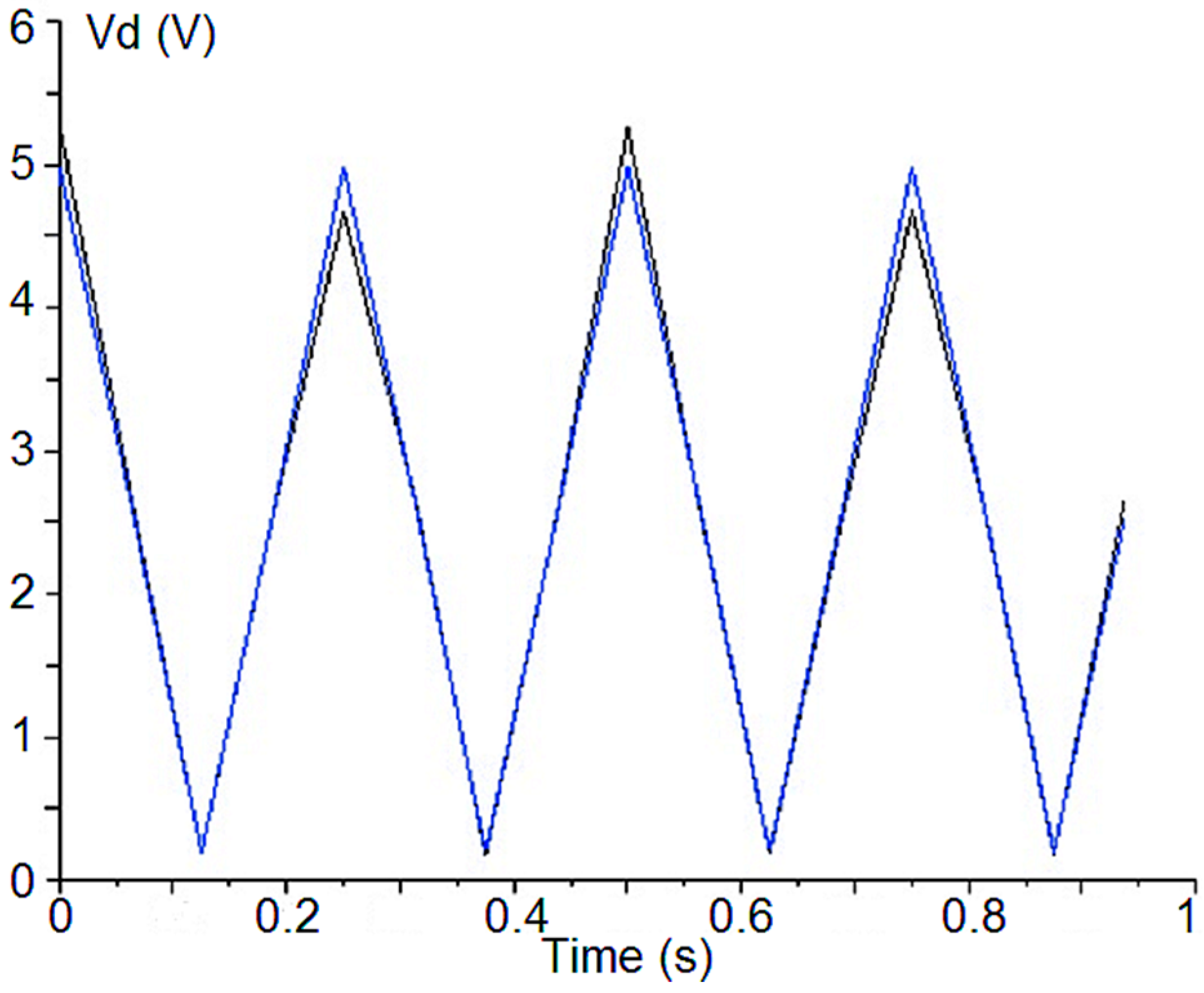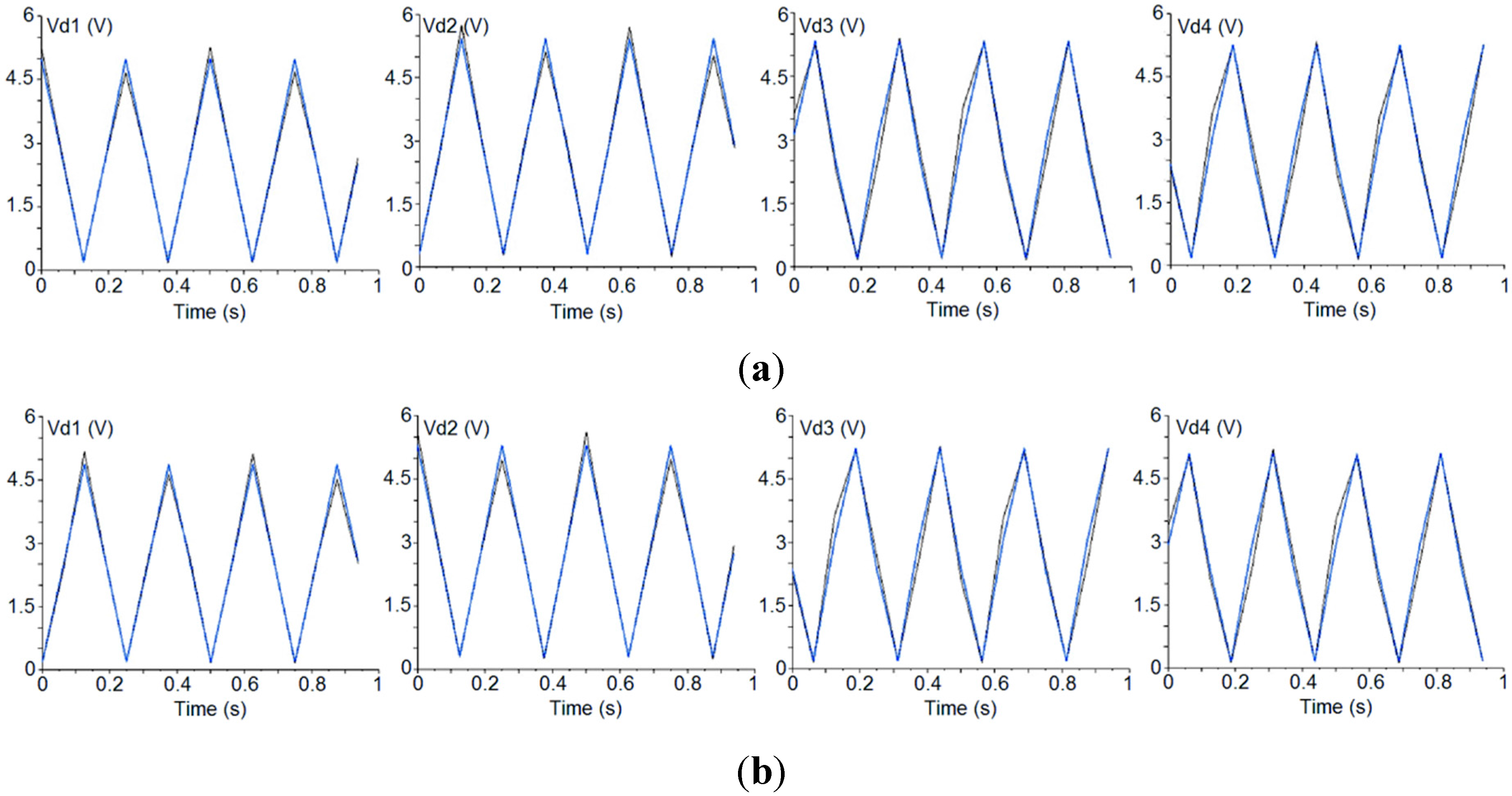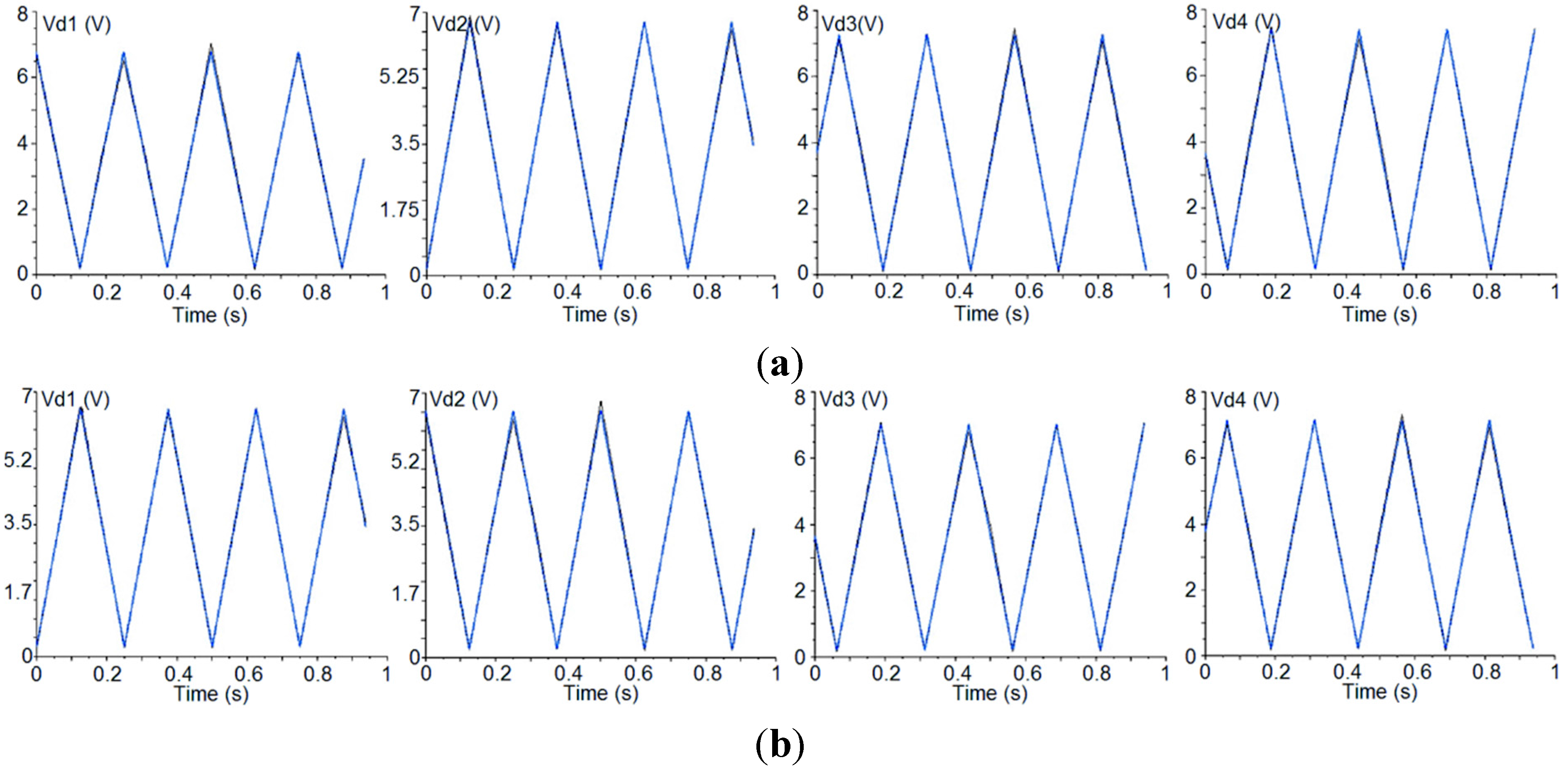A broad-band linearly polarized input signal was used to excite two pixels of the QUIJOTE TGI. The detected voltages at the BEM outputs were recorded to calculate Stokes parameters according to the polarization of the input signal. The receiver chains are two of the pixels that will be installed in the TGI at Teide Observatory. The FEM cryogenic LNAs have not been included in the receivers owing to the excess of signal power at room temperature. In any case, the functionality of the polarimeters is not affected by this since the optomechanics (feed-horn, polarizer, and OMT), PSMs, and CDMs are the more relevant modules in the overall polarimeter functionality.
3.1. Measurement Test-Bench
The polarimeter phase-adjustment and measurement process is carried out by exciting the receiver with broadband x-axis and y-axis linearly polarized signals respectively.
Figure 2 shows a sketch (a) and pictures of the measurement test-bench (b), and the noise source (c) used as excitation sources in the laboratory.
Figure 2.
TGI Polarimeter measurement test bench. (
a) Receiver functionality test bench (BEM details in
Figure 1). (
b) Polarimeter test bench with
x-axis linearly polarized source. (
c)
y-axis polarized source.
Figure 2.
TGI Polarimeter measurement test bench. (
a) Receiver functionality test bench (BEM details in
Figure 1). (
b) Polarimeter test bench with
x-axis linearly polarized source. (
c)
y-axis polarized source.
The broadband noise-like linearly polarized signal is accomplished using a 346C (option K01) noise source model from Agilent Technologies (Santa Rosa, CA, USA) together with a conical horn having a rectangular waveguide input. The orientation of the rectangular waveguide port determines the orientation of the radiated E-field within the cross-polarization limits of the horn. Between the noise source and the horn, a broadband LNA raises the signal power while the distance between the transmitting antenna and the receiver feed-horn is adjusted to avoid compression in the detectors. The two signals split up in the OMT outputs and are correlated in the last module of the chain. Since both signals are affected by a phase imbalance due to small differences in the electrical paths, one of the branches of the receiver is provided with a commercial PA coaxial component, which enables the minimization of the phase difference between branches. The detected voltages, once amplified with video amplifiers in a differential configuration, provide output levels lower than 10 V. These signals are sampled by a 24-bit resolution Data Acquisition System (DAS) [
18] (PXI-4495 from National Instruments, Austin, TX, USA).
As has been explained in the previous section, the combination of the 90°- and 180°-phase switches provides four phase states in each branch, resulting in sixteen redundant phase states in the overall pixel. The phase shift between the two branches of the pixel (ΦT) can be provided in a sequence given by the repetition of the four fundamental values (0°, 90°, 180°, and 270°) until covering the sixteen possible phase-states. The detected voltages of the polarimeter have been measured, covering all the phase switch states, in order to calculate the Stokes parameters after processing the obtained values. An acquisition period of one second has been used to cover the complete sequence of sixteen phase states.
3.2. Measurement and Phase-Adjustment Process
The polarization measurement method is a real-time process in which the detected signals are acquired by the DAS in the successive 16 phase states provided by the PSM. The resulting detected signals can be analyzed by means of a Fast Fourier Transform (FFT) in order to obtain their amplitude and phase and also to calculate the Stokes parameters. The measured waveforms are sinusoids but, as the detected voltages provide only four points per cycle, they are represented as saw-tooth waveforms in this work. To illustrate this situation and how the 16 phase states are achieved,
Table 2 shows the values of one of the four detected voltages (v
d) measured in the resulting sequence of phase-states.
If the FFT of v
d is called V
d, a simplified version of v
d can be reconstructed by means of the DC component (V
d[0]) and the fundamental harmonic (V
d[4]) following Equation (13):
f = 4 Hz in this case because in one second the sequence of four phase shift fundamental values between branches (0º, 90º 180º, and 270º) is repeated four times. For the example in
Table 2, these values are V
d[0] = 2.59 V and V
d[4] = 2.395 − 0.054i V respectively. The rest of the FFT harmonics are not taken into account because they can be considered as residual terms. By comparison of Equations (8)–(12) with Equation (13), it is easy to identify the Stokes parameters [
19] and some figures of merit related to them as the
Q/
U isolation (
ISO) and the polarization percentage (
Pol_perc) of the signal. Other parameters, such as the
phase of the signal, can also be calculated in order to get the phase-error of the polarimeter that is directly related with
ISO. Equations (14)–(19) define all these parameters.
Table 2.
Detected voltage values for each of the phase-states forming a saw-tooth waveform.
Table 2.
Detected voltage values for each of the phase-states forming a saw-tooth waveform.
| State | ΦT (deg) | ΦB2 (deg) | ΦB1 (deg) | vd (V) |
|---|
| 0 | 0 | 0 | 0 | 5.28 |
| 1 | 90 | 90 | 0 | 2.71 |
| 2 | 180 | 180 | 0 | 0.19 |
| 3 | 270 | 270 | 0 | 2.54 |
| 4 | 0 | 90 | 90 | 4.66 |
| 5 | 90 | 180 | 90 | 2.68 |
| 6 | 180 | 270 | 90 | 0.17 |
| 7 | 270 | 0 | 90 | 2.54 |
| 8 | 0 | 180 | 180 | 5.26 |
| 9 | 90 | 270 | 180 | 2.62 |
| 10 | 180 | 0 | 180 | 0.18 |
| 11 | 270 | 90 | 180 | 2.47 |
| 12 | 0 | 270 | 270 | 4.67 |
| 13 | 90 | 0 | 270 | 2.63 |
| 14 | 180 | 90 | 270 | 0.17 |
| 15 | 270 | 180 | 270 | 2.66 |
As can be observed in Equation (19), the
Ii value represents the polarization percentage as the parameters are normalized by the total intensity that is given by V
di[0] (see Equations (8)–(12) and Equation (13)). The index
i goes from 1 to 4, representing each detector output of the polarimeter.
Figure 3 shows the measured waveform of the detected voltage in
Table 2 (black trace) and the resulting waveform calculated from the FFT main harmonic values (blue trace).
The PA component setting is to minimize the phase-error over the detected signals. This error comes from both the electrical paths of the two polarimeter branches, including the PSM, and also the CDM. These errors are difficult to avoid because they come mainly from tolerances in the fabrication of every component of the polarimeter. In order to illustrate the effect of the adjusting phase over the waveform of a detected signal,
Figure 4 shows one detected signal before and after applying the phase correction. In the reported case, the phase of the signal should be 90°, so the phase error has decreased from 6.8° to 1.7°.
Figure 3.
Detected voltage waveform from
Table 2 values (black trace) and the resulting waveform calculated from the FFT of the measured values (blue trace).
Figure 3.
Detected voltage waveform from
Table 2 values (black trace) and the resulting waveform calculated from the FFT of the measured values (blue trace).
Figure 4.
Detected signal before (a) and after (b) phase-error correction.
Figure 4.
Detected signal before (a) and after (b) phase-error correction.
The PA component has a different effect on each detected voltage, so the following practical examples show how to measure polarization when instrumental errors are present.
3.3. Practical Measurement Examples
A first measurement example is illustrated in
Figure 5 where the upper part (a) shows the detected signals after the phase-adjustment process, exciting the polarimeter with a 100% x-axis polarized signal (
Figure 2b), and the lower part (b) shows the detected signals when using a 100% y-axis polarized signal (
Figure 2c) and the previously achieved phase adjustment.
Table 3 shows the parameters (Equations (14)–(19)) achieved from the detected voltages shown in
Figure 5. In the left columns
EY = 0, so it should be measured that
I =
Q and
U = 0. In the right columns
EX = 0, so we should get
I = −
Q and
U = 0.
Figure 5.
First polarimeter example: Detected signals resulting from the phase-adjustment process with an x-axis polarized input signal (a) and measurement process with a y-axis polarized input signal (b).
Figure 5.
First polarimeter example: Detected signals resulting from the phase-adjustment process with an x-axis polarized input signal (a) and measurement process with a y-axis polarized input signal (b).
Table 3.
Parameters calculated from the detected signals shown in
Figure 5 (Phase in Deg. and ISO in dB).
Table 3.
Parameters calculated from the detected signals shown in Figure 5 (Phase in Deg. and ISO in dB).
| Detector | Ux | Qx | Phasex | ISOx | Ix | Uy | Qy | Phasey | ISOy | Iy |
|---|
| 1 | −2.1·10−2 | 0.92 | −1.295 | −16.46 | 0.92 | 2.2·10−2 | −0.93 | 178.64 | −16.25 | 0.93 |
| 2 | −1.0·10−2 | 0.89 | 179.34 | −19.41 | 0.89 | 1.2·10−2 | −0.89 | −0.79 | −18.61 | 0.89 |
| 3 | 0.13 | 0.93 | −82.19 | −8.63 | 0.94 | −0.13 | −0.93 | 97.79 | −8.64 | 0.94 |
| 4 | 0.11 | 0.94 | 96.78 | −9.21 | 0.94 | −0.11 | −0.94 | −83.18 | −9.22 | 0.95 |
It can be seen that the PA component provides correct results in detectors 1 and 2 (good isolation and phase-error values), whereas detectors 3 and 4 remain uncorrected. In fact, it has been seen that, by using this component, it is possible to adjust the phase of only one pair of detectors (the one corresponding to Vd1 and Vd2 or Vd3 and Vd4) leaving the other pair uncorrected. This behavior arises because the polarimeter presents two main sources of phase error (the electrical paths of the polarimeter branches, including the PSM, that affects the four detectors and the 90°-phase-shifter of the CDM that affects only detectors 3 and 4) and one correction factor (the adjusting-phase component) that is able to correct only the error coming from the electrical paths of the polarimeter branches. So, in the general case, one pair of detectors will be corrected while the other pair will remain affected by the error in the 90º-phase-shifter of the CDM. Therefore, the need for redundant measurements using four detectors per polarimeter enables the following measurement solution to be proposed.
Until now, the 16 states provided by the PSM have been used, but the choice of only four independent states with the lowest phase-error is now considered. In principle there are 256 combinations of four independent states that could be analyzed. An exhaustive search of the optimal combination can be implemented in the FPGA that is used to perform the measurements but, for simplicity, here we have selected the last four phase states of the sequence (states numbered from 12 to 15 in
Table 2). They provide less error than others due to the lower difference between the detected values when
ΦT is 90 and 270°, as can be observed in
Table 2 by comparing states 13 and 15 with the pairs 1–3, 5–7 and 9–11.
Table 4 shows the parameters measured using these four independent states and a 100%
x-axis polarized excitation signal (left columns) and a 100%
y-axis polarized excitation signal (right columns). By comparing these results with those of
Table 3, the improvement achieved in the results is clear, thus providing more accurate measurement of the incoming polarization by using the four detectors of each polarimeter.
Table 4.
Parameters calculated by using only the states numbered from 12 to 15 in
Table 2 (Phase in Deg. and ISO in dB).
Table 4.
Parameters calculated by using only the states numbered from 12 to 15 in Table 2 (Phase in Deg. and ISO in dB).
| Detector | Ux | Qx | Phasex | ISOx | Ix | Uy | Qy | Phasey | ISOy | Iy |
|---|
| 1 | 5.72·10−3 | 0.89 | 0.37 | −21.91 | 0.89 | −1.24·10−3 | −0.9 | −179.92 | −28.62 | 0.9 |
| 2 | 1.07·10−2 | 0.87 | −179.29 | −19.09 | 0.87 | −1.62·10−2 | −0.86 | 1.08 | −17.26 | 0.86 |
| 3 | 1.13·10−2 | 0.94 | −89.31 | −19.22 | 0.94 | −2.87·10−3 | −0.97 | 90.17 | −25.27 | 0.97 |
| 4 | −1.22·10−2 | 0.98 | 89.27 | −18.95 | 0.98 | −6.6·10−3 | −0.95 | −90.41 | −21.48 | 0.95 |
On the other hand, some of the TGI polarimeters show a low enough phase-error to be used with the complete sequence of phase states. An example of these polarimeters with low phase-error is shown in
Figure 6, where the upper part (a) shows the detected signals after the phase-adjustment process, exciting the polarimeter with a 100%
x-axis polarized signal, and the lower part (b) shows the detected signals when using a 100%
y-axis polarized signal and the previously achieved phase adjustment.
Figure 6.
Second polarimeter example: Detected signals resulting from the phase-adjustment (a) and measurement (b) processes.
Figure 6.
Second polarimeter example: Detected signals resulting from the phase-adjustment (a) and measurement (b) processes.
The parameters calculated from the signals of
Figure 6 are presented in
Table 5. In this case the detector presenting the highest phase error is the number 4 but it is considered low enough to measure polarization, as the polarimeter still has to be calibrated to correct the remaining systematic errors.
Table 5.
Parameters calculated from the detected signals shown in
Figure 6 (Phase in Deg. and ISO in dB).
Table 5.
Parameters calculated from the detected signals shown in Figure 6 (Phase in Deg. and ISO in dB).
| Detector | Ux | Qx | Phasex | ISOx | Ix | Uy | Qy | Phasey | ISOy | Iy |
|---|
| 1 | 3.71·10−3 | 0.94 | 0.23 | −23.9 | 0.94 | 6.73·10−3 | −0.92 | 179.58 | −21.33 | 0.92 |
| 2 | 4.61·10−3 | 0.95 | −179.73 | −23.25 | 0.95 | 4.43·10−2 | −0.93 | −0.27 | −23.19 | 0.93 |
| 3 | −1.08·10−3 | 0.96 | −90.07 | −29.18 | 0.96 | 8.84·10−3 | −0.94 | 89.47 | −20.35 | 0.94 |
| 4 | 2.8·10−2 | 0.96 | 91.67 | −15.35 | 0.96 | −2·10−2 | −0.94 | −88.87 | −16.68 | 0.94 |
In the previous measurements it is possible to see a polarization percentage different from 100% (
I parameters should be equal to 1) when the excitation signal is 100% polarized and the instrumental offsets have been previously corrected. An external error source as one small part of unpolarized signal due to the free-space length between the noise source horn and the polarimeter horn (see
Figure 2b) could be the reason for that. In the following we will consider 3% of the input signal to be unpolarized. In such a case, we should have measured the same offset level in the four detectors but the detected signals shows different offset values. The reason for that will be considered in the following section.














